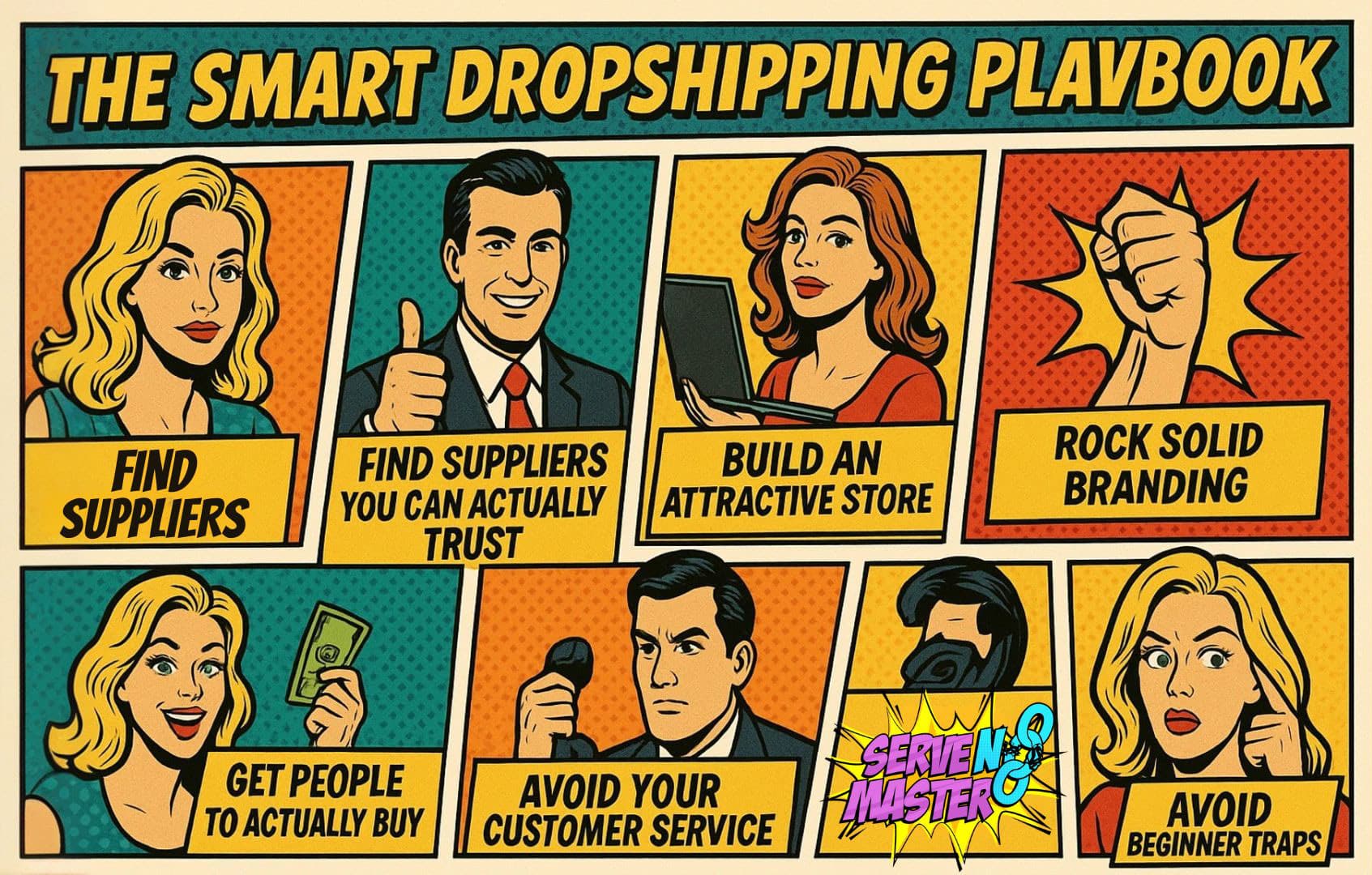How to Start Dropshipping in 2025 (The No-Hype Guide)
You’ve heard the siren song of dropshipping: Start an online store with almost no money down! Never touch inventory! Make sales while you sleep! Sell anything to anyone, anywhere!
It sounds like the ultimate entrepreneurial dream. And yes, the core model – where you market products that a third-party supplier ships directly to your customer – is appealing because it lowers the barrier to entry for e-commerce.
But let’s get brutally honest right upfront: Dropshipping in 2025 is not easy money. It’s not a guaranteed path to passive income, especially not quickly. The days of throwing up a generic store with random AliExpress products and instantly printing cash (if they ever truly existed) are long gone.
Competition is fierce. Customers are savvier. Ad costs are rising.
Does that mean dropshipping is dead? No. It means the lazy way is dead. The dumb way is dead.
But the smart way? Building a real brand, choosing the right niche, finding reliable suppliers, and focusing on customer experience? That still works. It just requires actual work, strategy, and treating it like the real business it is.
Ready to leave the job you hate and find the fastest path to online wealth? Learn the best asset you have right now to leverage income and build financial run way in my bestseller "Fire Your Boss." Click here to download the book for free.
If you’re willing to put in the effort and avoid the common pitfalls, here’s your no-hype roadmap to starting a dropshipping business the right way in 2025.
First: What Is Dropshipping, Really?
Just so we’re crystal clear:
- A customer buys a product from your online store at your retail price.
- You receive the order and payment.
- You forward the order details to your dropshipping supplier and pay them the wholesale price.
- The supplier packages and ships the product directly to your customer, often with your branding on the slip.
Your job isn’t handling products; it’s marketing, sales, branding, and customer service. The supplier handles logistics. It sounds simple, but success hinges on executing your parts exceptionally well and choosing the right partners.
Is Dropshipping Still a Viable Business in 2025?
Yes, absolutely – if you approach it correctly. The global e-commerce market is massive and still growing. Dropshipping remains a legitimate fulfillment model.
BUT…
- Competition is Insane: Because the barrier to entry is low, everyone tries it. Standing out requires more than just listing products.
- Margins Can Be Thin: Intense competition often drives prices down. You need to manage costs carefully and find ways to justify premium pricing such as branding and service.
- Supplier Reliability is Key: Your reputation rests on suppliers you don’t directly control. Bad products or slow shipping will kill your business.
- Customer Expectations are High: People expect fast shipping and good service, rivalling giants like Amazon. Long waits from overseas suppliers are less tolerated than they used to be.
Forget the idea of effortless riches. Think of dropshipping as a lean way to start an e-commerce brand, but one that requires significant effort in specific areas to succeed today.
The Smart Dropshipping Playbook for 2025: Step-by-Step

If you’re serious, here’s how to approach it:
Step 1: Niche Down Like Your Business Depends On It (Because It Does)
Forget general stores selling everything. You can’t compete with Amazon or Temu on variety or price. You must choose a specific niche.
- Passion + Profitability: Find a niche you have some interest in or knowledge about (it helps with marketing and motivation) AND that has proven market demand and profitability. People need to be actively buying products in this space.
- Solve a Problem or Serve a Passion: Does your niche solve a specific pain point such as ergonomic accessories for home offices? Or cater to a passionate hobbyist group (e.g. specialized gear for fly fishing)?
- Research: Use tools like Google Trends, explore social media hashtags and groups (TikTok, Reddit, Facebook), browse niche forums, check competitor stores. See what people are talking about, buying, and complaining about.
- Avoid Oversaturation: If a niche is absolutely flooded with identical dropshipping stores, it might be tough unless you have a truly unique angle or brand.
A well-defined niche allows you to target your marketing effectively and build a loyal audience.
Step 2: Find Suppliers You Can Actually Trust (The Hardest Part)
This is where most beginners fail. Relying solely on random, cheap AliExpress suppliers often leads to disaster (low quality, insanely long shipping times, poor communication).
- Vet Rigorously: Don’t just look at price. Check supplier ratings, reviews, and business history. Order samples yourself to test product quality before listing items. Assess their communication responsiveness.
- Look Beyond Basic AliExpress: Explore supplier directories (e.g., SaleHoo, Spocket, Zendrop – check their terms/fees). Some connect you with vetted suppliers, often in the US/EU for faster shipping.
- Consider Faster Shipping Options: Customers hate waiting weeks. Look for suppliers with warehouses in your target market (US, Europe) or those offering reliable, faster shipping lines (even if they cost a bit more – bake it into your price). Tools like Spocket or Zendrop often highlight suppliers based on location.
- Build Relationships: Once you find good suppliers, communicate regularly. Treat it like a real partnership.
Bad suppliers will sink your business through bad reviews and chargebacks. Do your homework here.
Step 3: Build a Store That Doesn’t Scream “Cheap Dropshipper”
Your website is your storefront. It needs to look professional and trustworthy.
- Choose Your Platform: Shopify is the dominant choice for a reason – user-friendly, scalable, huge app store (including many dropshipping integrations like DSers, Spocket, Zendrop). WooCommerce (on WordPress) offers more control but requires more technical setup. Choose based on your budget and tech comfort.
- Clean, Professional Design: Use a quality theme. Ensure easy navigation, clear product categories, and high-quality product images and videos. You can get samples or supplier photos, but edit and enhance them so they are unique to your website.
- Essential Pages: Include clear Shipping Policy, Return Policy, Refund Policy, Privacy Policy, Terms of Service, and Contact Us pages. This builds trust and is a legal requirement.
Your store needs to inspire confidence, not suspicion.
Step 4: BRANDING > Just Selling Random Products
This is crucial in 2025. You’re not just moving boxes; you’re building a brand.
- Unique Product Descriptions: Never just copy-paste the generic descriptions from your supplier. Write compelling, benefit-focused descriptions in your brand’s voice. Use keywords relevant to your niche. AI tools can help draft these, but always edit for accuracy and brand voice.
- Visual Identity: Create a decent logo and consistent color scheme.
- Brand Story/Angle: Why should someone buy from you specifically? What’s your unique value proposition or connection to the niche? Communicate this on your site.
People connect with brands, not just random product listings. Branding justifies potentially higher prices and builds loyalty.
Step 5: Get People to Actually Buy (Consistent Marketing)
You can have the best store and products, but without traffic, you have no business.
- Paid Advertising: Facebook Ads, TikTok Ads, Google Shopping Ads are common starting points. Requires budget, testing, and learning. Can burn cash quickly if done wrong. Start small, track results meticulously, scale what works.
- Search Engine Optimization (SEO): Optimize your product pages, descriptions, and potentially blog content for relevant keywords so people can find you via search engines. A longer-term play but brings “free” traffic.
- Content Marketing: Create valuable content such as blog posts, guides, videos that is related to your niche to attract your target audience organically.
- Social Media Marketing: Build a presence on platforms where your niche hangs out (Instagram, TikTok, Pinterest, Facebook Groups). Provide value, engage, and subtly drive traffic back to your store.
- Influencer Marketing: Collaborate with relevant influencers in your niche.
You must actively market your store. Expect to spend time and/or money here.
Step 6: Own Your Customer Service (It’s ALL On You)
Even though the supplier ships the product, you are the seller. The customer bought from you.
- Be Responsive: Answer customer inquiries promptly and professionally.
- Handle Issues: Deal with shipping delays, damaged items, or returns according to your stated policies. Liaise with your supplier to resolve problems, but communicate clearly and proactively with the customer.
- Manage Expectations: Be upfront about shipping times on your product pages and order confirmations.
Excellent customer service turns one-time buyers into repeat customers and prevents negative reviews that can cripple your store.
Avoid These Beginner Traps (Why Most Fail)
- Picking a Bad Niche/Product: No demand, too much competition, or terrible margins.
- Choosing Terrible Suppliers: Leads to low quality, slow shipping, unhappy customers.
- Ignoring Branding: Your store looks generic and untrustworthy.
- Zero Marketing Effort: Thinking customers will just magically find you.
- Awful Customer Service: Hiding from problems, slow responses.
- Unrealistic Expectations: Thinking it’s passive income from day one.
It’s a Real Business – Treat It Like One
Dropshipping can still be a profitable way to start an e-commerce business in 2025. The low initial investment in inventory remains attractive.
But make no mistake: it requires serious effort, strategic thinking, and a commitment to building a real brand and providing a good customer experience. Success hinges on diligent niche research, rigorous supplier vetting, smart branding, consistent marketing, and excellent customer service.
It’s not a shortcut to easy riches. It’s a business model with specific advantages and significant challenges. If you understand the realities, avoid the common pitfalls, and are prepared to put in the work, dropshipping can be your launching pad. Just don’t expect it to be effortless. Plan smart, execute diligently.
Ready to leave the job you hate and find the fastest path to online wealth? Learn the best asset you have right now to leverage income and build financial run way in my bestseller "Fire Your Boss." Click here to download the book for free.









